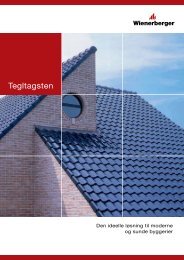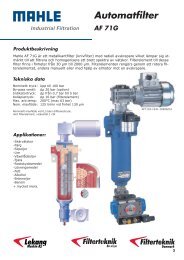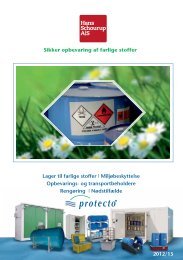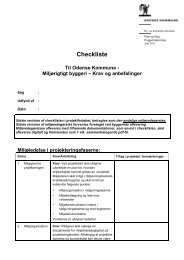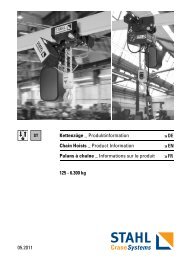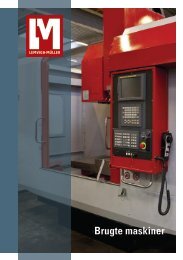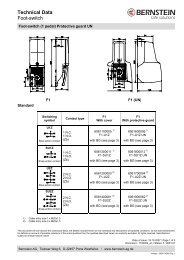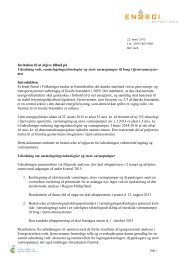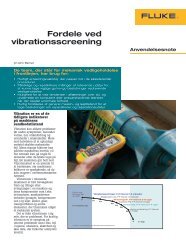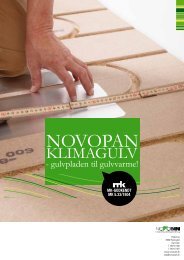Engineering plastics â The Manual - F.wood-supply.dk
Engineering plastics â The Manual - F.wood-supply.dk
Engineering plastics â The Manual - F.wood-supply.dk
You also want an ePaper? Increase the reach of your titles
YUMPU automatically turns print PDFs into web optimized ePapers that Google loves.
PEI<br />
PI<br />
O O C<br />
O<br />
n<br />
160<br />
O<br />
C<br />
O<br />
C<br />
H H<br />
O C C O<br />
H H<br />
n<br />
Structural PEEK formula PEEK<br />
120<br />
PET<br />
H<br />
H<br />
O<br />
O<br />
C<br />
n<br />
80<br />
C H 3<br />
C C<br />
n<br />
CH 2 H<br />
CH<br />
CH 3<br />
PEK<br />
Structural O formula PEK<br />
CH 3<br />
C<br />
O<br />
C<br />
O<br />
N<br />
O<br />
O CH O 3<br />
C<br />
O C<br />
O C C<br />
n<br />
O<br />
PEKEKK PEI Structural formula PEKEKK<br />
TECAPEEK<br />
O<br />
O<br />
S<br />
O n<br />
O<br />
C<br />
O<br />
n<br />
CH 2<br />
CH 2<br />
N<br />
• Stress [MPa]<br />
40<br />
PMP<br />
TECAPEEK TECAPEEK<br />
POM-C PI ST black TECAPEEK TECAPEEK HT black<br />
H H<br />
C C<br />
n<br />
H<br />
CH 2 H<br />
C O<br />
n<br />
CH<br />
H 3 CH<br />
CH 3<br />
O<br />
O<br />
O<br />
O<br />
C<br />
C<br />
C<br />
C<br />
-R H<br />
N H H<br />
N -R N<br />
n<br />
n<br />
0<br />
C OC<br />
C C O<br />
0 5 l<br />
10m<br />
n<br />
15<br />
C<br />
20<br />
C<br />
• Strain [%] H O H H<br />
O<br />
O<br />
TECAPEEK ST sw<br />
TECAPEEK HT sw<br />
O<br />
C<br />
C<br />
O<br />
N<br />
m<br />
n<br />
PES PEK<br />
PAEK (DIN designation)<br />
<strong>The</strong> group of polyaryletherketones (PAEK) encompasses in<br />
the main PEEK, PEK, PEKEKK and PEKK.<br />
<strong>The</strong> molecular structure of the members of this polymer<br />
group differs in terms of the respective number of cohesive<br />
ether and ketone groups. Consequently, with an increasing<br />
number O of Oketone H groups, H underlying distinctions occur<br />
with C rising Cglass O transition C C O<br />
n<br />
and melting temperatures. Processability<br />
by melting becomes increasingly difficult, and is<br />
H H<br />
then replaced by pressing methods, which are the preferred<br />
PET<br />
option for large-scale semi-finished product dimensions.<br />
A typical characteristic of this group of materials, which is<br />
classified as part of the thermoplastic high-temperature<br />
plastic group, is that its property profile is largely maintained<br />
Oalso in high-temperature<br />
O<br />
O<br />
ranges above O 100 °C; Most<br />
O<br />
characteristic C values C change only C moderately. C<strong>The</strong> most important<br />
N material and the one with N the -R most N technical uses<br />
C<br />
-R<br />
n<br />
is the polyetheretherketone C<br />
PEEK. C<br />
C<br />
C<br />
<strong>The</strong> materials O belonging to the O polyaryletherketone O group O<br />
are characterized by an unusually complex property profile<br />
PI<br />
with a large number of excellent individual characteristics.<br />
Properties<br />
ˌˌSemi-crystalline<br />
ˌˌLow density<br />
H H<br />
ˌˌHigh degree of toughness<br />
ˌˌHigh strength, hardness and rigidity<br />
ˌˌLow tendency to creep<br />
C H 3<br />
PMP<br />
C C<br />
n<br />
CH 2 H<br />
CH<br />
CH 3<br />
N<br />
POM-H PMP<br />
ˌˌGood sliding friction properties,<br />
good abrasion resistance<br />
ˌˌVery good chemical resistance to<br />
a wide range of technical media<br />
ˌˌHydrolysis resistance,<br />
tendency to stress crack formation<br />
ˌˌHigh thermal H H stability<br />
C C<br />
ˌˌUnusually high n radiation resistance<br />
H CH<br />
to gamma and 3<br />
X-rays<br />
ˌˌVery low moisture absorption<br />
PP<br />
ˌˌMinimal thermal expansion<br />
ˌˌGood dimensional stability<br />
ˌˌInherently flame resistant, self-extinguishing<br />
ˌˌMinimal ion contamination<br />
ˌˌVery low outgassing rates in high vacuum<br />
ˌˌMinimal, low-toxicity gas development<br />
CH 3<br />
in case of fire<br />
m<br />
CH<br />
Values<br />
3<br />
TECAPEEK TECAPEEK HT TECAPEEK ST<br />
PPO > PPE? (PEEK) (PEK) (PEKEKK)<br />
T g 150 °C 160 °C 165 °C<br />
PPS<br />
S<br />
O<br />
n<br />
n<br />
Density 1.31 g/cm³ 1.31 g/cm³ 1.32 g/cm³<br />
Modulus of elasticity 4,200 MPa 4,600 MPa 4,600 MPa<br />
Service temperature, long-term 260 °C 260 °C 260 °C<br />
Service temperature, short-term 300 °C 300 °C 300 °C<br />
Lower service temperature –40 °C –40 °C –40 °C<br />
(Exceptions down to –100 °C,<br />
increasing brittleness)<br />
36



